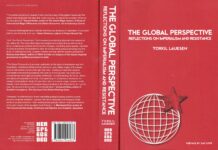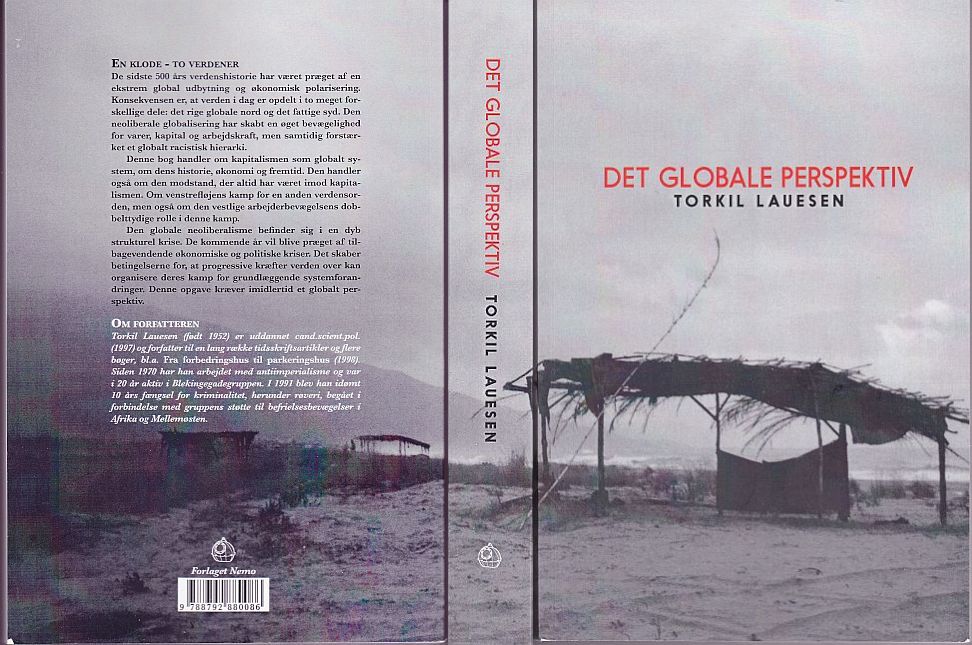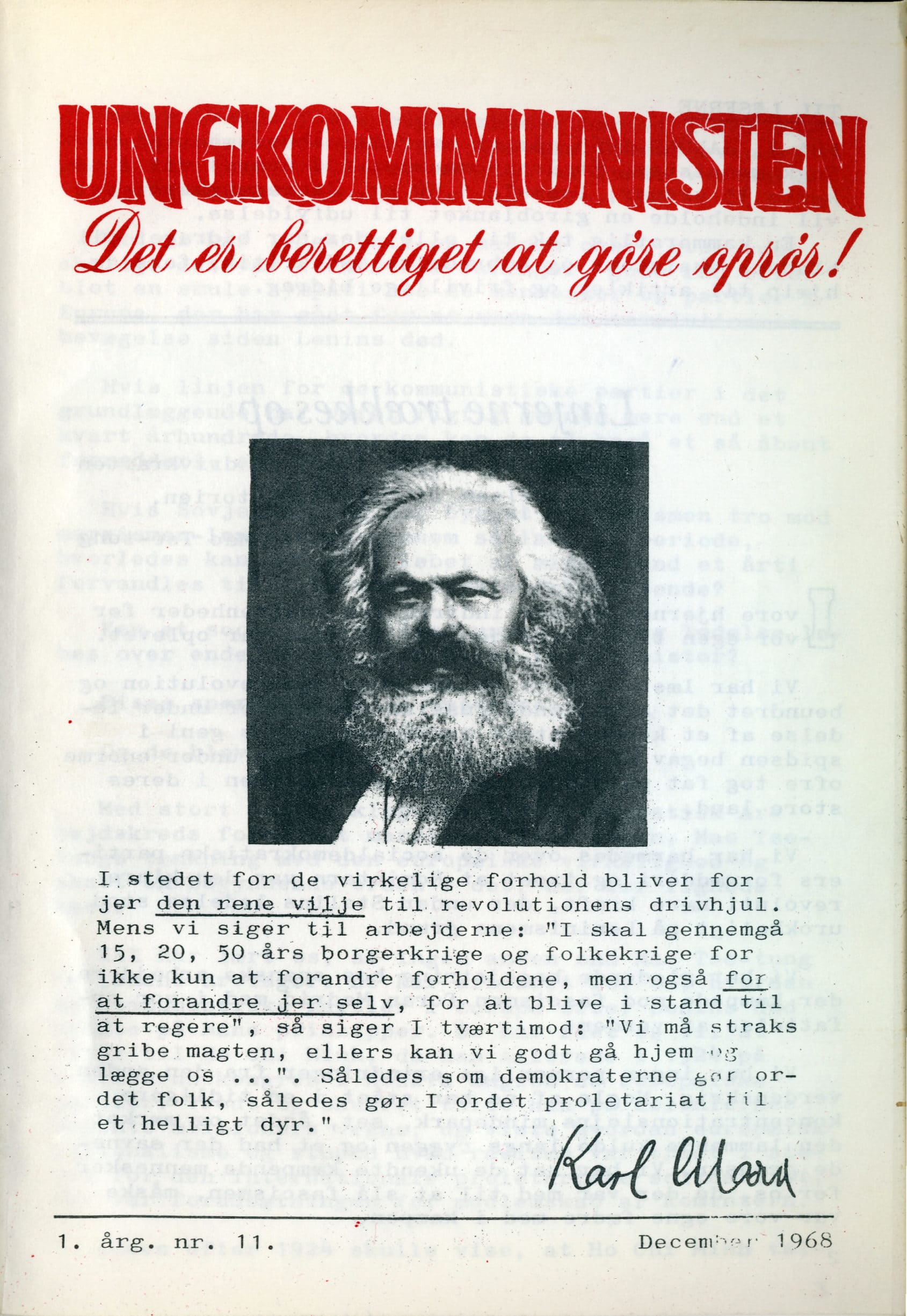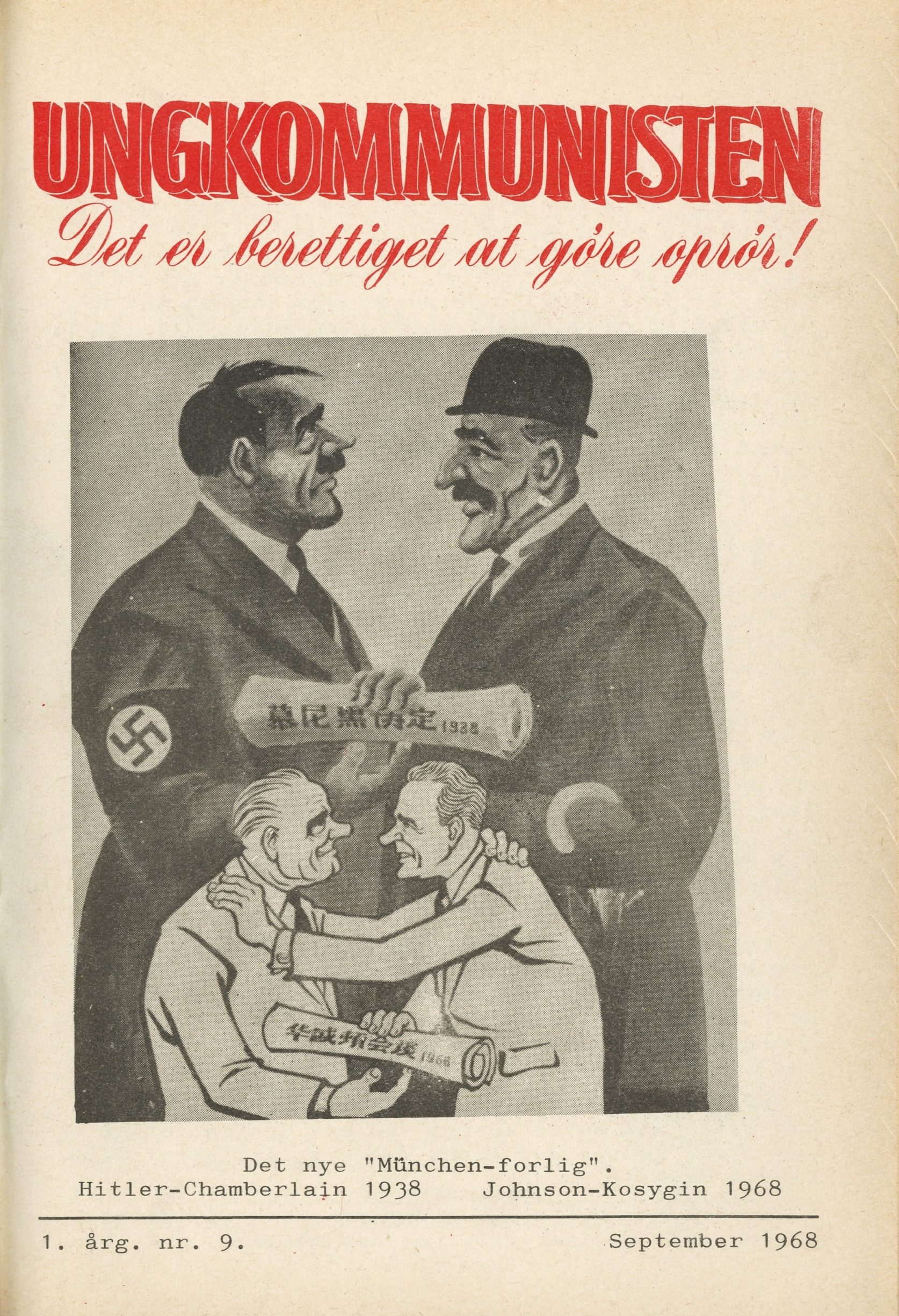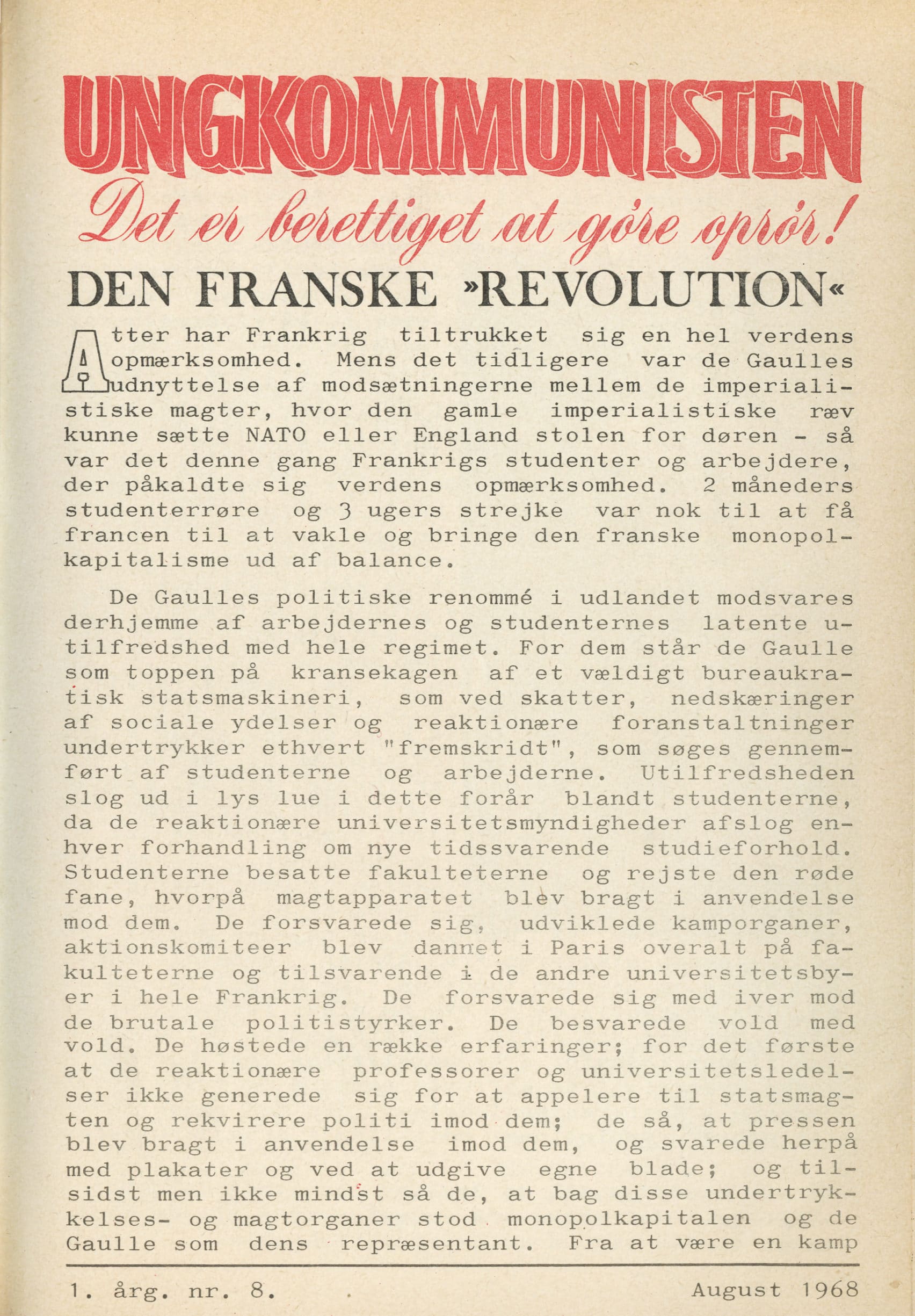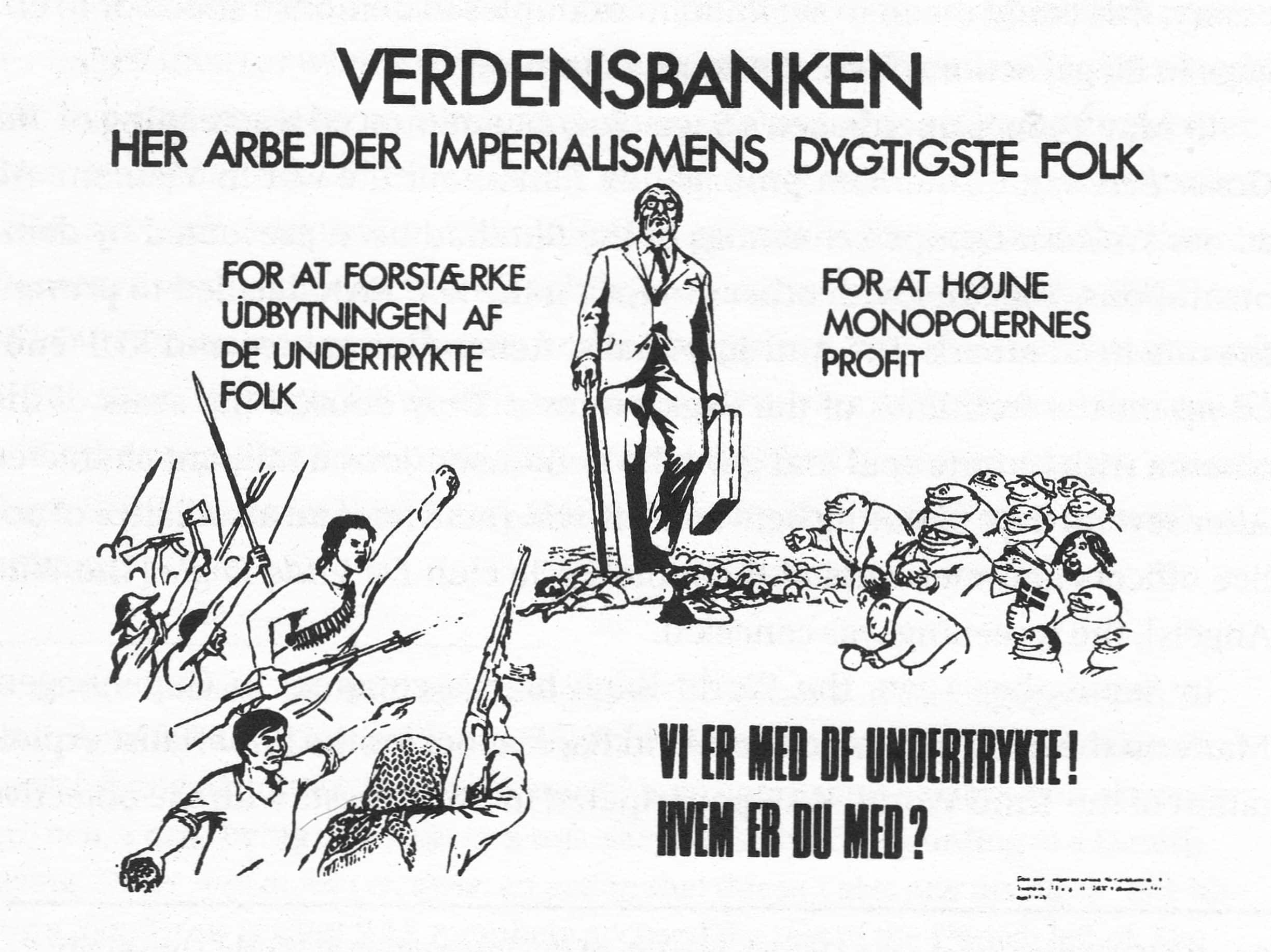Introduction
From the end of World War II and until the Oil Crisis in 1973, when the recession began to be felt, capitalism had existed almost without crises in the imperialist countries. The period was characterized by an increase in prosperity for the majority of the population of these countries as never seen before. The working class achieved its lot by the increasing real wages. Cars, refrigerators, television sets, stereo sets, and other electronic equipment became necessities. Travel, weekend cottages, bungalows, yachts etc. became obtainable objects for a big part of the workers in the imperialist countries. The youth became large-scale consumers of clothes, music, and fashions. Guaranteed minimum wages, unemployment insurance, sickness insurance, social relief programs, etc., removed the potentially lethal poverty in the case of unemployment, and sickness. Capitalism received a “human face” in Western Europe and North America.
The main working class party, the Social Democracy, came into power in most West European countries without changing the imperialist character of these states. The national interests of the imperialist countries included both the working class and the bourgeoisie. The prosperity of the countries became the prosperity of all classes so that the population of the rich countries constitutes the upper class of today’s world. In other parts of the world capitalism did not mean prosperity but economic, social and political crisis. To the exploited countries in Asia, Africa and Latin America capitalism means gross exploitation, plundering of natural riches, oppression of elementary human and democratic rights, and wretched poverty. The high wages in the rich countries determine and are determined by the fact that a majority of the population of the world live in poverty and wretchedness and receive wages which hardly cover their mere physical reproduction cost. The efficient industrial struggle of the North American and Western European working classes together with the brutal suppression of the political and industrial struggles in the Third World have resulted in large differences in wages in the world.
Conversely, the international mobility of capital, which has grown particularly after World War II, has resulted in a tendency towards a global equalization of the rate of profit. In general, capital invested in the Third World does not yield considerably higher rates of profit than capital invested in the imperialist countries. Therefore, the international differences in wages can be felt in the prices. Commodities from low-wage countries are cheap and commodities from high-wage countries are expensive. When the two groups of countries exchange commodities, value is transferred from the low-wage countries to the high-wage countries. This is the fundamental thesis of the theory of unequal exchange, which is based on two prerequisites:
1. Wages
Unequal payment of the labour-power. Internationally, the class struggle has been fought on an unequal economic basis, which has led to the wage level and consequently the rate of surplus-value varying enormously.
2. Profit
Equal payment of the capital. The mobility of capital is sufficient to produce a tendency towards an international equalization of the rate of profit.
Below we shall deal with the validity of these two prerequisites, and in this chapter we shall include concrete economic facts.
Variation in Wages in a Divided World
Introduction
Under capitalism, labour-power is a special commodity. Special because the price of the commodity, the wages, does not primarily reflect economic rules but political conditions. The wage level reflects the strength of the working class in relation to the bourgeoisie and depends on the economic framework which the society in question has provided for wage-variation.
Wages form part of the social product. Thus, apart from being the price for labour-power, wages constitute an important and basic element in the distribution of the social production. Wages and profit are two parts of a connected whole, two parts of the social production. The distribution of this production is determined by the struggle of the classes.
The price of labour-power is determined by moral and historical elements, just as the market for labour-power is full of norms, rules, and regulations. These reflect the relative strengths between the classes. They result in a tendency towards an equalization of the wage-level within the individual countries, particularly within the imperialist countries. This also means that the rate of exploitation is equalized. The tendency towards an equalization of the national wages is partly due to the comparatively high mobility of the labour-power within the country and partly to political intervention.
Internationally, a similar tendency has not been seen, on the contrary. Historically, there has been a tendency towards a growing gulf between the wages in the poor countries and the wages in the rich countries. Today the differences in wages are bigger than ever. There is not one world market price for labour-power as is the case with the majority of other commodities. There are many prices. However, the main tendency is that wages are divided into two kinds: subsistence wages to the proletariat in the exploited countries and comparatively high wages to the workers in the imperialist countries in North America, Northern Europe, Japan, Australia, etc. This tendency not only continues but is becoming more prominent.
From the break-through of capitalism and until the middle of the nineteenth century, there were only limited differences in wages internationally. Subsistence wages were prevailing, as they had been for centuries to the extent that wage-labour had existed. The variations which could be seen reflected climatic and other natural conditions, which made life easier or more difficult. In their theories, the classical economists Adam Smith and David Ricardo presupposed constant and equal wages. To them and their contemporaries wages were closely identified with the subsistence level. And studies of the conditions of wages and prices during the first ten years of the nineteenth century do show a close relation between wages and the price of bread. Expenses for bread alone amounted to about 50 per cent of the wages for a working-class family. (The studies have been quoted by Emmanuel, Unequal Exchange, pp. 49-50.) As mentioned above, it was the industrial struggle in Britain in the 1860s which made the wages increase slowly. The concrete differences in wages which have occurred in the world since then will be discussed below.
The Concrete Variations in Wages
A global study of wages by Cairnes in 1874 (quoted by Emmanuel, op. cit., p. 46) comes to the following results: wages in the United States were 25-50 per cent higher than in Britain, 48-70 per cent higher than in Belgium, and about 100 per cent higher than in France. If we consider countries such as India and China, American wages were about 4-5 times as high. During the one hundred years which have passed since then, this tendency has become much more emphasized. Today the differences in wages between the imperialist countries and the exploited countries are not 4-5 times but 10-20-30 times. Table 4.1 gives an outline of the time rates in the industries of a number of selected countries, which are characteristic of both the imperialist countries and the exploited countries. The figures in the table correspond to the wage level in the sectors which in the countries in question produce for the world market.
As it appears in Table 4.1, there are considerable international wage variations in the case of industrial workers. In the case of agricultural workers the wage differences are even more pronounced, as it appears from the table, since agricultural workers in the Third World receive wages which are lower than the industrial workers of the countries in question. This applies especially to the exporting plantations which produce coffee, cocoa, tobacco, tea, rubber, peanuts, bananas, cotton, and similar commodities, which are mainly consumed by the population of the imperialist countries and by the middle and upper classes of the exploited countries. Agricultural workers in the Third World are paid about 30 times less than the workers of the richest countries.
It is evident that a table like this is vitiated by errors and uncertainty, but other studies (see for example A. G. Frank Crisis In the Third World, London, 1981, pp. 179-182, or Fröbel, Heinrichs, Kreye, The New International Division of Labour, Cambridge, 1980, p. 361) and our own experiences from travels in the Third World confirm the main results of the investigation.
If we use the figures in Table 4.1 and weigh them with the number of industrial workers in the countries in question, the average figure representing the wages of the industrial workers appears:
Imperialist countries: about $5.60 per hour
Exploited countries: about $0.46 per hour
As it has been impossible to find reliable figures for the number of agricultural workers in most countries and, as many of the wage figures for agricultural workers do not represent the real renumeration, we have chosen to estimate on the basis of the figures available the ratio of the number of industrial workers to agricultural workers and the ratio of the wages in industry to agriculture, and have reached the following result:
The ratio of the number of industrial workers to agricultural workers:
Imperialist countries: 18:1
Exploited countries: 1.3 : 1
The ratio of the wages of the industrial to the agricultural workers:
Imperialist countries: 1.4:1
Exploited countries: 2:1
Thus the average wages of both industrial and agricultural workers can be calculated:
Imperialist countries: $5.50 per hour
Exploited countries: $0.36 per hour
Thus wages are, in general, 15 times higher in the imperialist countries than in the exploited countries.
In the following, we shall use this ratio of the wages in the imperialist countries to the exploited countries (15:1) in our calculations, well aware that this method of calculation is not the safest. Several things indicate that the difference in wages is bigger in real life. The wages which are actually paid in the poor countries, are often lower than the ones stated. This is due to sheer evasion of agreements and legislation on the part of the employers (ibid., p. 353). [1] Furthermore, the statistics often only apply to organized labourers. In the Third World many labourers are not organized and they get even lower wages than the organized members of their own class. In many imperialist countries the employer pays insurance, pensions, etc., which are not paid directly to the workers. These amounts ought to appear as part of the wages. Thus it would perhaps be much nearer reality, if we estimated a wage difference of between 15 to 25 times, instead of the 15 times which we have chosen as our basis of calculation.
Table 4.1 Hourly wages (US dollars)
| Country | Industry | Agriculture | ||||
| Year | Wage | Year | Wage | |||
| Africa | ||||||
| Egypt | 1973 | 0.22 | — | — | ||
| Kenya | 1978 | 0.94 | 1977 | 0.23 | a,b,d | |
| Nigeria | 1978 | 0.44 | 1975 | 0.30 | RT,c | |
| Tanzania | 1974 | 0.45 | 1974 | 0.26 | d | |
| Zambia | 1976 | 0.75 | 1976 | 0.33 | c | |
| Ghana | 1970 | 0.40 | — | — | ||
| Latin America | ||||||
| Argentina | 1977 | 0.22 | 1977 | 0.18 | U | |
| Bolivia | 1977 | 0.61 | RT | — | — | |
| Brazil | 1976 | 1.23 | — | — | ||
| Colombia | 1978 | 0.65 | — | — | ||
| Chile | 1978 | 0.60 | 1978 | 0.22 | RT,c | |
| Equador | 1977 | 0.75 | — | — | ||
| Mexico | 1976 | 0.97 | 1978 | 0.49 | RT,d* | |
| Asia | ||||||
| Bangladesh | 1977 | 0.14 | RT,S | 1977 | 0.09 | RT,S,c |
| Burma | 1977 | 0.17 | — | — | ||
| Hong Kong | 1978 | 0.70 | RT | — | — | |
| India | 1975 | 0.15 | 1977 | 0.06 | RT,d | |
| Japan | 1978 | 6.79 | 1976 | 1.67 | M,d | |
| do. | 1.33 | W,d | ||||
| Pakistan | 1975 | 0.19 | 1978 | 0.12 | c | |
| Philippines | 1975 | 0.25 | 1975 | 0.11 | a,b,c | |
| Singapore | 1978 | 0.79 | — | — | ||
| Sri Lanka | 1978 | 0.21 | 1978 | 0.07 | d | |
| South Korea | 1979 | 1.06 | 1978 | 0.86 | M,RT,d | |
| do. | 0.65 | W,RT,d | ||||
| Turkey | 1977 | 0.84 | 1977 | 0.80 | d** | |
| Europe | ||||||
| Denmark | 1978 | 8.76 | 1978 | 6.51 | c | |
| Spain | 1976 | 1.99 | 1978 | 1.43 | c | |
| France | 1978 | 4.18 | 1976 | 2.10 | a,b,c,d | |
| West Germany | 1978 | 6.42 | 1978 | 3.96 | M,RT,d | |
| do. | 3.02 | W,RT,d | ||||
| Greece | 1978 | 1.85 | — | — | ||
| Italy | 1977 | 3.07 | — | — | ||
| Switzerland | 1979 | 7.23 | 1978 | 7.07 | M,c*** | |
| do. | 5.19 | W,c*** | ||||
| Sweden | 1978 | 7.52 | 1978 | 6.10 | M,c,d | |
| do. | 5.49 | W,c,d | ||||
| Great Britain | 1978 | 3.97 | M | 1977 | 2.68 | M,c |
| do. | 2.74 | W | 2.15 | W,c | ||
| Oceania | ||||||
| Australia | 1978 | 5.88 | M | — | — | |
| do. | 4.69 | W | ||||
| New Zealand | 1979 | 4.29 | 1978 | 2.61 | RT,c | |
| North America | ||||||
| Canada | 1979 | 6.34 | 1978 | 3.17 | RT,c | |
| USA | 1979 | 6.66 | 1978 | 3.07 | RT,a,b,c,d |
RT: The amount shows the wages agreed to through collective bargaining. It is usually the minimum wage. In the exploited countries this figure will almost correspond to the actual wages or it may be just above.
M: Men; W: Women; S: Skilled; U: Unskilled.
a: Besides the wages stated, free meals are granted.
b: Besides the wages, free lodgings are granted.
c: The total wages are paid cash.
d: Some of the wages are paid in kind. The statistics show only the amount paid in cash.
* Day-labourer; ** Fishermen; *** Woodmen.
Source: The figures have been calculated on the basis of various UN and ILO statistics as well as on the basis of Fröbel, Heinrichs, Kreye, op. cit., p. 351.
Working Conditions
The wages paid to the industrial and agricultural workers in the exploited countries are often not enough to cover the physical, reproduction costs of the labour-power. The wages in these countries are often simply not high enough to keep the working force alive. This is evident when the wages are compared with the prices of basic foodstuffs. If the labourer does not get any kind of supplement from his family who works on subsistence farms, the consequence will be an extremely rapid attrition and change of labour-power. A rate of change of 5-7 per cent each month and of 50-100 per cent annually is not abnormal within industries and plantations in the Third World. (Fröbel, Heinrichs, Kreye, op. cit., pp. 529-30) Within the electronics industries of Asia, e.g. in Hong Kong, Singapore, Malaysia, and Taiwan, young female labourers are preferred. They have no family life, domestic work or child minding to take care of beside their work and are therefore able to work harder and longer hours, up to Sixty hours weekly. They do not participate in the maintenance of the family and are therefore paid low wages. After 3-4 years of back-breaking work at the microscopes they are worn down. Their sight and nerves can no longer comply with the demand of the production for speed and accuracy and they are fired – or as it is called “encouraged to retire and marry”. New and fresh labour-power is employed (Frank, op. cit., p. 164). Fröbel, Heinrichs and Kreye have looked into the working hours in the Third World:[2]
In most of the countries where free production zones and world market factories are in operation the standard working week is forty-eight hours. The difference between this figure and the standard working week of forty to forty-four hours in the traditional industrialised countries is only a partial reflection of the real prolongation of the working day in the new production sites in the developing countries. The high number of weeks worked in the year, the large amount of overtime and the low number of days off serve to prolong the total annual working time still further, so that the labour-force in some world market factories works up to 50% more hours per year than the traditional industrial countries. For example, working hours in manufacturing industry in Hong Kong often amount to more than sixty hours per week.(a) In the world market factories in South Korea the usual working week of the factory worker is sixty hours.(b) Total productive hours per year amounts to approximately 2800, compared with 1860 on the average in Federal Germany.(c) Workers in South Korean industry are required to work seven days, eighty-four hour weeks – i.e. a twelve hour shift each day without rest days.(d) In Thai manufacturing industry a nine hour working day with only one day off per month is often required.(e)
(Op. cit., pp. 353-5.)
When the authors lay stress on a working week of 60 hours it is not an unique example. “There is no legal restriction of the working day for men over the age of 18 years”, as advertised by Hong Kong Trade Development Council. In 1968, 52 per cent of all workers in Hong Kong worked 10 hours a day or more. 58 per cent of the labour-force worked 7 days a week. According to a survey made in 1971, 171,439 out of 700,000 industrial workers worked 75 hours a week or more. Of these 13,792 worked 105 hours or more a week, which corresponds to 15 hours a day. The same year 36,000 children worked illegally in Hong Kong. (Frank, op. cit., p. 169. This book contains several atrocious examples from Brazil and South Korea among other countries.) Conditions have not improved since then, on the contrary. These conditions can be compared to the worst Manchester capitalism in Britain in the 1830s.
Productivity and Wages
The Myth of the Low Productivity in the Exploited Countries
One of the most popular explanations of the international wage differences is that they are based on similar differences in productivity. This explanation is also used as an objection against the theory of unequal exchange. As established in Chapter 3, this explanation is theoretically wrong because the extra profits temporarily yielded by productivity increases fall first and foremost to the capitalist. The fact that increases in productivity are used by the unions of the imperialist countries as an argument for higher wages in the case of collective bargaining does not mean that productivity increases are an economic factor which regularly pushes up wages. Whether the working class succeeds in benefitting from productivity increases does not depend on the actual increases but on the relative strength of the working class and the capitalist class. The wages are not the price for the results of the work but the price for the labour-power.
However, the view that the productivity of the export sectors in the Third World is lower is wrong. The enterprises in, the Third World are not generally characterized by low productivity. Often one finds a rate of productivity which corresponds to that of the imperialist countries – if they can be compared at all. The same technology is used. Samir Amin, who has been dealing with this, writes:
… the exports of the Third World are not, in the main, made up of agricultural products coming from backward sectors with low productivity. Out of an overall total of exports from the underdeveloped countries of the order of $35 billion (in 1966), the ultramodern capitalist sector (oil, mining, and primary processing of minerals, modern plantations – like those of United Fruit in Central America, or Unilever in Africa and Malaya) provides at least three-quarters, or $26 billion….
As regards the other exports of the Third World, provided by the backward sectors, with low productivity (agricultural produce supplied by peasantries of the traditional type), is the situation less clear? Here the differences in the reward of labour (the term “wage” is out of the place in this context) are accompanied by a lower productivity. How much lower? It is all the harder to say because the products involved are, as a rule, not comparable: tea, coffee, cocoa are produced only in the periphery. It can be safely suggested, however, that rewards are proportionately much lower in the periphery than are productivities. An African peasant obtains, for example, in return for 100 days of very hard work every year, a supply of imported manufactured goods the value of which amounts to barely twenty days of simple labour of a European skilled worker.
(Samir Amin, Unequal Development, p. 143. )
The really low rate of productivity can be found on the subsistence farms in the agricultural areas, the development of which is blocked by the unequal development, which again is a consequence of the unequal wage level. But this part of the economy of the Third World does not influence the exportation to the imperialist countries.
A large number of studies of individual enterprises and analyses of various industries show that the rate of productivity – defined as output per head – is by and large the, same in the world market industries in the Third World and in the rich countries. The multinational company Philips has concluded – based on surveys in 1970 and 1978 into the enterprises of the company in Europe, Japan, Australia, and in the Third World – that the productivity (measured as produced units per labourer) is more or less the same in these areas (Le Nouveau Journal, Paris, 18/4. 1979). On the basis of a number of studies, Deutsche Entwicklungsgesellschaft concludes that the rate of productivity of the industries in the exploited countries which have turned their production towards the world market is only a little lower than the rate of similar industries in Western Europe. In the light of the longer working hours in the Third World, the workers have a much higher rate of performance than the workers of Western Europe. (These studies and the following are quoted from Fröbel, Heinrichs, Kreye, p. 356.) According to studies made by The United States Tariff Commission, the rate of productivity of workers in American-owned enterprises outside the United States is by and large the same as the rate of productivity of workers within the same lines of industry in the United States. According to these studies, the workers in the clothing industry of the exploited countries produce just as many units per hour as their American colleagues do. Certain studies even conclude that the rate of productivity of the industries in the exploited countries is higher than that of the imperialist countries. So Baerresen concludes in a report that the productivity in American-owned enterprises in Mexico in certain cases is considerably higher than it is in similar enterprises in the United States. For example in the case of the electronics industries, the Mexican rate of productivity was 10-25 per cent higher than it was in the United States. According to Baerresen, American managers in Mexico report that South Korean labour-power is a further 10-40 per cent more productive than the Mexican labour-power. The American managers have also worked for American firms in South Korea. Managers in the United States and Western Germany, who were the heads of Malayan textile and electronics enterprises, unanimously stressed after a few months of production that the rate of productivity in Malaya was the same as at home. Another American study by R. W. Moxon concludes that as far as the electronics industry is concerned the rate of productivity is generally higher in the exploited countries than in the United States.[3]
It should be stressed that in these studies the definition of productivity is the number of units produced per labourer within a given time unit. As the rate of productivity turns out to be the same or higher in the exploited countries, it is often due to a much higher labour intensity in the Third World. Very often many of the manual operations are mechanized or automatized in the imperialist countries. This means that the labourers in the Third World have to work much more intensively to achieve the same rate of productivity. If the working processes have not been mechanized, in this part of the world, it is only due to the wages being so low that it would not be of any advantage to the capitalists to mechanize.
In the exploited countries the rate of productivity is often much higher within mining and plantations than in the imperialist countries. This is first and foremost due to natural (geologic, climatic etc.) prerequisites, although this does not change the situation. The actual differences in productivity cannot be explained away, whatever the reason is for their existence. As the world looks today, it would be extremely costly for the imperialist countries, both as far as labour hours and money are concerned, to produce most of the “exotic” products within for example mining and plantations. (See Emmanuel, Unequal Exchange Revisited, p. 33.).
Productivity and Wages – Final Remarks
Productivity increases are primarily for the benefit of the capitalists and should be looked upon as a part of the mutual competition of the capitalists. Productivity increases are not effected because the capitalists “want” them, but because they are constantly forced to improve the productive forces. The capitalists who produce at the quickest speed and at the lowest price do best in the competition. And, therefore, they try to limit the production costs of which the wages make up a considerable part. It is a fact that improved conditions of production in the form of lower wages can be felt in the prices. The consequence is – as has already been stressed above – that value is transferred from the exploited countries to the imperialist countries. But it also means that the industries in the Third World outstrip industries in the imperialist countries to the extent that the same commodities are produced. This tendency can be seen very clearly within shipbuilding, textile manufacturing, and certain electronics industries where, in particular, South East Asian low-wage industries outstrip the high-wage industries of the Western World, which often survive only by means of political intervention, government subsidies etc. The rapid growth of the South East Asian industries and the crises in the corresponding industries in the Western World should be a sufficient proof that there is a strong connection between wages and prices. High wages mean expensive commodities: low wages mean inexpensive commodities. It is just as evident that this applies to all exporting economies in the Third World, even though it is most evident within the industries where the low-wage companies do best in the competition. Many economists of various political views refuse to recognize these realities. On the western economists’ hypocrisy and dual attitude to this problem, Emmanuel writes:
When it is a question of importing coffee or bananas, which the rich countries do not themselves produce, and the low prices of which can consequently be only to the advantage of the purchasing countries, then any notion of artificially increasing prices is repudiated in the name of the sound principles of economic rationalism, and no allusion to the low wages of the producers is allowed, since, in accordance with these same sound principles, these wages are not the cause of prices ‘but their effect. When, however, by chance the poor countries decide to export products such as Indian cotton goods or Japanese transistors, which are already included in the production of a traditional branch of industry in the rich countries, then all these principles are cheerfully forgotten, and. it is discovered that it is only proper that the rich country should make up by means of artificial tariff barriers for the equally artificial difference in wages; thus brusquely and brazenly admitting that wages are not the effect of prices but their cause.
(Unequal Exchange, pp. 69-70.)
It is often called “social dumping” when low-wage industries by means of child labour etc., combined with modern technology, crush the industries of the rich countries.
The factors of price formation are related to the unequal exchange by Emmanuel, who goes thoroughly into the matter:
But if this conjunction causes the prises of Indian cotton goods and Japanese ships to be abnormally low, why are the prices of bananas and coffee not also abnormally low, since wages in these branches are just as exotic and productivity is undoubtedly higher than in the West? (Has anyone ever thought what it would cost to grow bananas or coffee in Flanders or the Rhineland?)
“Unfair competition by means of low wages”, “pauperized labor”, “social dumping”, etc., are expressions of which present-day writing on economic matters is full, while pure economics goes on imperturbably teaching that wages depend on prices, and not the other way round.
In the days when wages varied from one country to another only as 1 to 2, or even 1 to 3 or 1 to 4, it was perhaps legitimate to suppose that fluctuations on the commodity market could be the underlying cause of these variations. When, however, wages vary at the rate of 1 to 20.or 1 to 30, and vary only in space, while possessing extreme rigidity in time (in which only a slow and linear trend is to be observed, with hardly any variation), we are indeed compelled to recognize that they probably vary in accordance with laws peculiar to themselves and that, consequently, they really are the independent variable of the system.
Conclusion
We cannot but conclude that the first assumption, which we made a condition of the validity of the theory of unequal exchange, is in accordance with reality. Unequal pay of the labour-force does exist. Internationally, the class struggle has been fought on an unequal economic basis, which has resulted in the wage level and thus the rate of surplus-value being at least 15 times higher in the imperialist countries than in the exploited countries.
Equalization of the Rate of Profit
The other condition of the validity of the theory of unequal exchange – namely an equal return on capital wherever it is invested – depends on the mobility of capital. In this connection mobility means that the capital has the possibility of moving. Thus it is not necessary that the capital actually moves in order to be characterized as capital with sufficient mobility for creating an equalization of the rate of profit. If there are no stimuli attracting capital and it does not move, it cannot be concluded that it is immobile. The international mobility of capital depends on the political barriers set by the various countries to capital imports and exports.
The establishment and the following extension of the colonial system at the end of the nineteenth century and the beginning of the twentieth century increased the trade and the international movement of capital between the imperialist and the exploited countries. Usually, these capital movements took place within the individual colonial empires. But at the time Britain made comparatively big investments in North and South America which were outside her empire. However, it was difficult for the individual colonial powers to invest in the empire of other powers, and the United States, which had no colonies, was restrained by the colonial system.
The decolonization, the establishment of the OECD [4], and the political development after World War II meant greater freedom to the capital movements in the capitalist world both between the imperialist powers and between these and the exploited countries. These improved possibilities of international mobility of capital meant increased competition between the capitals, as capital flow towards branches and areas where the rate of profit is high, and away from branches and areas where the rate of profit is comparatively low. These continuous changes in the rates of profit of various branches and areas result in capital movements which again result in an equalization of the rate of profit to an international average. This average forms the axis around which the rate of profit varies continuously. However, the tendency towards an equalization of the rate of profit does not exclude the existence of “super profits” in some sectors at the same time as an equalization takes place in the other sectors.[5]
Statistics on international rates of profit are rather problematic. Partly because the information on which the statistics are based is unreliable, as tax and book-keeping conditions may lead to the rates of profit quoted not being in accordance with the “real” rates. Partly because detailed information is seldom found in the statistics as to how the rates of profit quoted have been calculated. However, the available statistics – although vitiated by uncertain factors – mainly confirm the assumption that the rate of profit is equalized internationally.
R. A. Lehfeldt, who has looked into British rates of profit during the years 1898-1910, declares that the return on colonial securities [6] was 0.2 per cent higher than the return on British securities of the same time. The return on foreign securities was 1 per cent higher than that on British securities (FEIS, Europe: The Worlds Banker, quoted from Emmanuel, Unequal Exchange Revisited, p. 51). “R. P. Dutt compares the respective rates of profit in Britain and in the British colonies. He finds, for the year 1951, differences in gross profit ranging from 34 to 47 per cent. If, says John Strachey, he had taken 1950 instead of 1951, he would have found, instead, the figures 25 and 29 per cent.” (R. Palme Dutt, Crisis of Britain and the British Empire, and Strachey, End of Empire, quoted from Emmanuel, Unequal Exchange, p. 43. )[7]
One of the critics of Emmanuel, Klaus Busch, has published a table (4.2) to reject the theory of unequal exchange. If the petroleum and mining industries are omitted, the table actually shows that the rate of profit does not vary materially between the exploited (“underdeveloped”) countries, and the imperialist (“developed”) countries. There is complete agreement between the rates of profit of the individual sectors in both groups of countries as regards, both the American-owned industries and the British-owned industries in which the mining sectors are also included. The high rate of profit of US-owned oil companies in the exploited countries and the corresponding very low rate of the same companies in the imperialist countries could rather be an indication of a book-keeping transfer of profit to the exploited countries for tax reasons, than a matter of, actual variations in the rates of profit.
Table 4.2 Return of direct capital investments in developing countries and developed countries made by the United States, Britain and West Germany
| Investing Country | Return on investment in | |
| Developing | Developed | |
| countries, % | countries, % | |
| United States: | ||
| Manufacturing industry | ||
| 1951-70 | 11.2 | 11.7 |
| 1951-60 | 11.6 | 13.9 |
| 1961-70 | 11.0 | 11.0 |
| Other industry | ||
| 1951-70 | 10.2 | 11.6 |
| 1951-60 | 11.1 | 11.8 |
| 1961-70 | 9.6 | 11.5 |
| Petroleum | ||
| 1951-70 | 27.7 | 3.8 |
| 1951-60 | 29.3 | 6.5 |
| 1961-70 | 26.9 | 2.8 |
| Mining | ||
| 1951-70 | 16.8 | 11.2 |
| 1951-60 | 13.5 | 11.1 |
| 1961-70 | 18.9 | 11.2 |
| Britain: | ||
| All sectors exc. petrolèum | ||
| 1961-69 | 10.4 | 10.0 |
| West Germany: | ||
| All sectors | ||
| 1965-69 | 6.3 |
(Source: K. Busch in “Problemen des Klassenkampfes”, No. 8-9, Deutsches Institut fur Wirtschaftsforschung: Wochenbericht, 22/72, Berlin 1972, pp. 199-202.)
As far as the figures are correct, they can in no way reject the fact that the rate of profit is equalized internationally, especially because extremely high profits may occur periodically in certain sectors (as for example mining) without influencing the general tendency of equalization. Thus these specific sectors do not participate in the equalization.
Table 4.3 and the comment to it is quoted from Emmanuel, Unequal Exchange Revisited, p. 52.
Table 4.3 American direct investment in manufacturing industry. Movement of the rate of profit (in per cent)
| Year | Canada | Latin America | Europe |
| 1960 | 8.2 | 9.9 | 12.8 |
| 1961 | 5.2 | 10.0 | 12.4 |
| 1962 | 8.6 | 8.7 | 10.1 |
| 1963 | 9.0 | 7.7 | 11.1 |
| 1964 | 9.1 | 9.6 | 11.8 |
| 1965 | 8.7 | 9.8 | 11.3 |
| 1966 | 8.1 | 10.3 | 9.6 |
| 1967 | 7.5 | 7.5 | 8.6 |
| 1968 | 7.9 | 10.2 | 9.6 |
(Source: “Documentation Française”, 15 March 1971.)
It appears that, with the exception of Canada which enjoys preferential conditions due to neighbourhood, language and other links, the two other groups, Latin America and Europe, the one under- or semi-developed, the other developed, show a remarcable convergence with or even a slight superiority to Europe, which runs counter to what the supporters of the non-equalization thesis want to prove.
(Op. cit., p. 52.)
The tendency towards an equalization of the rate of profit does not necessarily mean that the rate of profit is the same in all countries. Capital invested in the exploited countries often yields a few per cent more (“danger money”). The social unrest in the Third World, the threat of a possible nationalization etc., cause the investing capitals to demand a higher rate of return if they are to invest abroad, If, for example, the rate of profit is 10 per cent in the United States, it may be 15 per cent in Thailand, and 20 per cent in Namibia or El Salvador. However, this does not prevent an equalization in the long view.
About the studies of the tendency towards an equalization of the rate of profit Emmanuel concludes:
If the physical mobility of labour, even when now and then it becomes quite important, is not – as we have seen – sufficient to bring about the equalization of wages, generally a marginal mobility of capital on the international plane is indeed quite sufficient – experience shows – to generate a clear tendency towards the equalization of its rate of remuneration. The economists who deny this tendency generally base their position on logical inferences, while all those who have undertaken empirical investigations are unanimous in acknowledging the fact that there are no meaningful differences in the rates of profit between developed and under-developed countries.
Capital Movements
The variations in the rates of profit in the world can be studied in an indirect way by looking at the capital movements, as capital moves towards the highest rate of return. Table 4.4 shows the distribution of the investments of the imperialist countries.
Table 4.4 Stock of direct investment abroad of developed market economies, 1967-75
| Year | Total value | Investment in | |
| ($ billion) | Developing | Developed | |
| countries, % | countries, % | ||
| 1967 | 105 | 69 | 31 |
| 1971 | 158 | 72 | 28 |
| 1975 | 259 | 74 | 26 |
(Source: UN, Transnational Corporations in World Development, New York, 1977)
Thus in 1975 three quarters of the total investments of the imperialist countries were directed towards the same imperialist countries. Only one quarter was invested in the exploited countries, and their relative share even seems to decrease. The reason why investments are scarce in the Third World is not a lack of social need for capital investments nor unfavourable terms on the part of the governments of these countries. On the contrary, most countries in the Third World are very interested in receiving foreign investments. This applies both to the countries of a capitalist outlook and the regimes of more or less planned economy. Many countries and groups of countries in the Third World even lay down conditions of capital investment which are more favourable than those of the imperialist countries. They try to attract capital, for instance, by establishing free trade and tax free areas. The reasons why the imperialist countries attract by far the largest part of the total world investments, and the reasons why the Third World is not capable of attracting more capital than it actually does, are that the imperialist countries have an enormous domestic market, whereas the exploited countries have a very limited one.
Thus the limits of the world market offer possibilities of investing only a little more than 25 per cent in the exploited countries and about 75 per cent in the imperialist countries. If higher rates of profit existed in the Third World in general, capital would flow to that part of the world, and the total investments would grow faster in the exploited countries than in the imperialist countries. That is not the case. Profits created in the Third World even flow to the imperialist countries to a certain extent, instead of being reinvested in the exploited countries. The share of the total investments in the Third World decreases.
Emmanuel quotes a Cuban study with approval:
… the best proof that the rate of profit in the underdeveloped countries is not particularly high is provided by the investment in the developed countries of a large part of the capital held by the national bourgeoisies of the backward countries.
(Unequal Exchange, p. 44)
The latest example of capital exports to the imperialist countries is the oil billions of the Arab countries, which to a great extent return to the United States and Europe as investments in industries and as hot money. Of course, this applies particularly to the OPEC countries with a capitalist economy such as Saudi Arabia, Kuwait, and the United Arab Emirates. In 1980 the OPEC countries had. invested $343 billion in the United States and Western Europe, and investments in the imperialist countries by OPEC are estimated to reach more than $1,000 billion in 1985.
We can establish that the differences in the rate of profit are much smaller than the wage differences, and whereas the wage differences follow the national borders, there is no indication of the rates of profit doing the same.[8] Investigations by J. Dunning show on the contrary that the rate of profit can be higher for years in high-wage imperialist countries compared to most low-wage exploited countries. [9] The low wages in the exploited countries do not result in particularly high rates of profit. In general, we can state that the tendency towards an equal return on capital, no matter where it is invested, can be seen at an international level.[10]
Conclusion
Thus we conclude that the conditions of an exploitation of the low-wage countries of the Third World through unequal exchange are present. On the basis of the enormous differences in wages which exist between the imperialist countries and the exploited countries, and through an international equalization of the rate of profit, values can be transferred from the poor exploited countries to the rich imperialist countries because of the low prices of products from the exploited countries and the high prices of products from the imperialist countries.
The Size of the Unequal Exchange
In the end one country can only exploit another country by importing commodities of a total value which is higher than the value of the exported commodities. This may take place by simple plundering as was the case during early colonialism. Or it may take place by having a constant trade deficit as Britain had during the last century. Finally, it may take place through a distortion of the actual prices at which the commodities are sold, which is the case today between the imperialist countries and the exploited countries. The imperialist countries sell their commodities at prices which are too high compared to the value, and the exploited countries sell at prices which are too low.
The size of this transfer of value is difficult to calculate precisely. In the following we should like to give just an impression of the size in question. Below we shall consider the world trade in a more concrete way in order to estimate the size of the unequal exchange. Table 4.5 shows the development of world trade from 1948-82 between the imperialist countries, the exploited countries, and the centrally planned economies both in absolute figures (i.e. in prices) and in percentages.
Table 4.5 World trade by region, 1948-1982 (FOB prices* in $billion and percentage distribution)
| Export from | Year | World | Export to | |||||
| total | Developed | Developing | Centrally | |||||
| market ecs. | market ecs. | planned ecs. | ||||||
| Total | % | Total | % | Total | % | |||
| Developed | 1948 | 36.5 | 23.7 | 65 | 11.3 | 31 | 1.5 | 4 |
| market | 1956 | 68.4 | 45.9 | 67 | 19.0 | 28 | 1.7 | 2 |
| economies | 1965 | 128.0 | 95.3 | 74 | 25.9 | 20 | 5.2 | 4 |
| 1970 | 224.2 | 172.5 | 77 | 41.4 | 18 | 8.9 | 4 | |
| 1975 | 577.2 | 402.0 | 70 | 138.0 | 24 | 33.8 | 6 | |
| 1980 | 1260.6 | 894.0 | 71 | 293.4 | 23 | 61.2 | 5 | |
| 1982 | 1161.2 | 802.9 | 69 | 289.6 | 25 | 53.0 | 5 | |
| Developing | 1948 | 17.3 | 11.8 | 68 | 5.0 | 29 | 0.5 | 3 |
| market | 1956 | 24.9 | 18.3 | 73 | 5.9 | 24 | 0.8 | 3 |
| economies | 1965 | 35.9 | 25.6 | 71 | 7.4 | 21 | 2.6 | 7 |
| 1970 | 54.9 | 39.8 | 72 | 10.9 | 20 | 3.4 | 6 | |
| 1975 | 209.4 | 146.7 | 70 | 49.0 | 23 | 10.1 | 5 | |
| 1980 | 558.5 | 391.5 | 70 | 138.9 | 25 | 20.5 | 4 | |
| 1982 | 486.5 | 312.2 | 64 | 145.6 | 30 | 23.7 | 5 | |
| Centrally | 1948 | 3.7 | 1.5 | 41 | 0.4 | 11 | 1.7 | 46 |
| planned | 1956 | 10.1 | 2.0 | 20 | 0.9 | 9 | 7.2 | 71 |
| economies | 1965 | 21.8 | 4.7 | 22 | 3.3 | 15 | 13.8 | 63 |
| 1970 | 32.8 | 7.8 | 24 | 5.1 | 16 | 19.9 | 61 | |
| 1975 | 84.6 | 23.1 | 27 | 13.3 | 16 | 47.6 | 56 | |
| 1980 | 175.1 | 56.4 | 32 | 31.6 | 18 | 85.5 | 49 | |
| 1982 | 189.0 | 58.5 | 31 | 41.5 | 22 | 88.9 | 47 |
* FOB (Free on board) prices: The prices at the frontier of the exporting country – excluding international transport and insurance charges.
Source: UN, Statistical Yearbook, 1978 and 1981, UN, Monthly Bulletin of Statistics No. 5, May 1984. – UN statistics place People’s Republic of China, Mongolian PR, PDR of Korea, and Vietnam, in the group of centrally planned economies together with the East European countries and the USSR. Cuba, Angola and Moçambique are placed in the group of developing countries with market economy.
Let us look at the importance of Third World export to the imperialist countries. From table 4.6 it appears that the imports of the imperialist countries from the Third World amount to about one quarter of the total imports, calculated on the basis of the current world market prices. Furthermore, if this figure is compared to the national product of the imperialist countries, imports from the Third World amount to about 4-6 per cent. The fact that imports from the exploited countries make up a relatively small part compared to the trade between the imperialist countries, and an even smaller part compared to the national product of these countries in terms of world market prices, could induce one to believe that the importance of trade with the Third World and thus of the unequal exchange was comparatively small. But nothing could be more wrong. Rather, the opposite conclusion should be drawn. Because the unequal exchange is, indeed, based on the disproportionately low prices of commodities from the Third World, which result in disproportionately low trade figures. The lower the wages are, the lower the prices and the lower the trade figures. The argument that the comparatively small trade with the Third World should show the inferior importance of the unequal exchange, indicates that the theory of unequal exchange has been misunderstood.
Table 4.6 Exports to developed market econmies (FOB prices, $billion)
| Year | Total | From developed | From developing | From centrally | |||
| market economies | market economies | planned economies | |||||
| Total | % | Total | % | Total | % | ||
| 1965 | 125.6 | 95.3 | 76 | 25.6 | 20 | 4.7 | 4 |
| 1970 | 220.7 | 172.5 | 78 | 39.8 | 18 | 7.8 | 4 |
| 1975 | 571.9 | 402.0 | 70 | 146.7 | 26 | 23.1 | 4 |
| 1980 | 1341.9 | 894.0 | 67 | 391.5 | 29 | 56.4 | 4 |
| 1982 | 1173.5 | 802.9 | 68 | 312.2 | 27 | 58.4 | 5 |
(Source: UN, Statistical Yearbook 1981, and UN, Monthly Bulletin of Statistics No. 5, May 1984)
Table 4.7 Exports to developing market economies (FOB prices, $billion)
| Year | Total | From developed | From developing | From centrally | |||
| market economies | market economies | planned economies | |||||
| Total | % | Total | % | Total | % | ||
| 1965 | 36.6 | 25.9 | 70 | 7.4 | 20 | 3.3 | 9 |
| 1970 | 57.3 | 41.4 | 72 | 10.9 | 19 | 5.1 | 9 |
| 1975 | 200.3 | 138.0 | 69 | 49.0 | 25 | 13.3 | 7 |
| 1980 | 464.0 | 293.4 | 63 | 138.9 | 30 | 31.6 | 7 |
| 1982 | 476.7 | 289.6 | 61 | 145.6 | 31 | 41.5 | 9 |
(Source: UN, op.cit.)
It is far more interesting and more significant to look at the distribution of the exports of the Third World. From table 4.5 it appears that about 70 per cent of the exports of the Third World are exported to the imperialist countries. The internal trade between the countries of, the Third World amounts only to 25-30 per cent. Furthermore, this trade is relatively less important for, the transfer of value between the countries, as they have more or less the same wage level. Exports to the socialist countries – the centrally planned economies – amount to about 5 per cent only. Thus the imperialist countries import by far the, majority of the cheap commodities from the Third World, and in this way they benefit from the unequal exchange and exploit the Third World.
From table 4.7 it appears that 60-70 per cent of Third World imports comes from the imperialist countries. Some 20-30 per cent is internal trade between the exploited countries, and 7-9 per cent is imported from the planned economies. Thus both as regards exports from the Third World and as regards imports to the Third World, the imperialist countries are predominant, whereas the “socialist countries” – the centrally planned economies keep to themselves to a much larger extent.
The internal trade between the imperialist countries accounts for a considerable part of total world trade in terms of world market prices. In 1982 total world trade amounted to $1,836.6 billion, out of which inter-imperialist trade amounted to $802.9 billion. However, this trade is of less direct importance in comparison with international transfers of value between the imperialist countries and the exploited countries, because the wage differences between the imperialist countries are relatively small compared to the global wage differences.[11] However, inter-imperialist trade is of importance to the distribution of the values from the exploited countries, which take place by trade in further processed commodities.
The contents of inter-imperialist trade also differ from trade between the imperialist countries and the Third World. inter-imperialist trade is to a large extent an exchange of the same products, whereas trade with the Third World is based on the exchange of different products. Denmark sells Bang & Olufsen and buys Philips, Sony and Grundig. West Germans buy Volvo, Fiat, Toyota, and Citroën and sells VW, Mercedes, and BMW. The exchange of a large number of industrial products, machines, and consumer goods has only one function, namely to extend the choice as regards shape and colour.
The case of trade between the imperialist countries and the Third World is different. The Third World exports commodities which to a large extent form the material basis of the production of the industrialized countries. In return, imperialist countries sell a large number of industrial products to the Third World. To the extent that the countries in the Third World start lines of industry which have so far only existed in the industrialized countries, they are very competitive, as we have stressed before.
Table 4.8 EEC dependence on raw materials from developing countries (percentage 1972)
| Materials | EEC import | Developing | Developing | Developing |
| dependence | countries’ | countries’ | countries’ | |
| share of | share of | share of | ||
| EEC import | world export | world import | ||
| Exhaustable raw materials | ||||
| Industrial raw materials | ||||
| Copper | 100 | 60 | 44 | 93 |
| Tin | 86 | 85 | 77 | 93 |
| Iron | 75 | 55 | 42 | 99 |
| Bauxite | 83 | 50 | 88 | 99 |
| Phosphate | 99 | 63 | 43 | 83 |
| Manganese | 100 | 45 | 51 | 99 |
| Tungsten | 95 | 43 | 50 | 100 |
| Energy raw materials | ||||
| Uran | 75 | 15 | 98 | |
| Petroleum | 98 | 98 | 45 | |
| Natural gas | 3 | 100 | 5 | |
| Coal | 11 | 1 | 10 | |
| Reproduceable raw materials | ||||
| Tropical products | ||||
| Coffee | 100 | 99 | 97 | 96 |
| Cocoa | 100 | 97 | 98 | 96 |
| Tea | 100 | 80 | 84 | 79 |
| Bananas | 100 | 100 | 95 | 96 |
| Spices | 100 | 100 | 90 | |
| Industrial raw materials | ||||
| Timber | 50 | 29 | 43 | 92 |
| Leather | 23 | 23 | 99 | |
| Rubber | 100 | 100 | 98 | 91 |
| Cotton | 60 | 57 | 82 | |
| Wool | 12 | 13 | 94 | |
| Jute | 100 | 98 | 95 | 88 |
| Sisal | 100 | 100 | 97 | 94 |
| Agricultural products | ||||
| Meat | 35 | 20 | 95 | |
| Oil-seeds | 100 | 43 | 88 | |
| Fruit | 45 | 25 | 93 | |
| Sugar | 99 | 73 | 82 | |
| Corn | 25 | 10 | 80 | |
| Rice | 55 | 40 | 21 | |
| Tobacco | 24 | 21 | 89 |
(Source: EEC commission.)
Table 4.8 shows the qualitative dependence of the EEC on trade with the Third World. It is difficult to make exact calculations of the size of the unequal exchange. Partly because the information on wages and on the size of the labour-force is subject to some uncertainty. Partly because it is difficult to estimate the wage-share of the price of the product. Therefore, the following estimate is only meant as an illustration of an approximate size. The calculations have been made on the basis of 1980 figures:
According to table 4.5 the exports of the exploited countries to the imperialist countries amount to:
$391.5 billion
The exports of the imperialist countries to the exploited countries:
$293.4 billion
Assuming that wages amount to 20 per cent of the price of the products from imperialist countries and 15 per cent of the price of the products from exploited countries, the wage-share amounts to:
Of exports from exploited countries: $58.7 billion
Of exports from imperialist countries: $58.7 billion
According to the International Labour Organization (ILO, International Labour Review, 1974, vol. 109, no. 5-6, pp. 422-9) there are about 400 million people engaged in active employment in the imperialist part of the world – and about 800 million people engaged in active employment in the non-“socialist” part of the Third World.
If we assume that wages in the imperialist countries are 15 times higher than wages in the exploited countries, we can fix the wages in the exploited countries at 1 and the wages in the imperialist countries at 15. Thus we can calculate an average wage-factor.
Labourers of imperialist countries:
400 mill. at factor 15 = 6000 million
Labourers of exploited countries:
800 mill. at factor 1 = 800 million
Total number:
1200 mill. at average factor = 6800 million
Average wage factor: 6800 / 1200 = 5.7
The factor 5.7 reflects the global average wages. Paid by means of these average wages the wage-share of the exports would be:
Of exports from the exploited countries:
58.7 billion x 5.7 / 1 = $334.7 billion
Of exports from the imperialist countries:
58.7 billion x 5.7 / 15 = $22.3 billion
The wage share is now again added to the remaining production costs, and the following prices of exports appear:
Exports from exploited countries:
391.5 x 85% + 334.7 = $667.5 billion
Exports from imperialist countries:
293.4 x 80% + 22.3 = $257.0 billion
Compared to this hypothetic situation of equal wage the gain of the imperialist countries from unequal exchange amounts to:
From low import prices:
667.5 – 391.5 = $276.0 billion
From high export prices:
293.4 – 257.0 = $36.4 billion
Total gain in 1980: $312.4 billion
By way of comparison it may be mentioned that in 1980 the GNP of USA was $2,573 billion.
The amount of the repatriated profits of the multinationals from investments in the Third World during the period 1970-78 was about $100.2 billion. (Fidel Castro, Speech at the Conference of the Interparliameniarian Union in Havana, 15-23 August 1981, Granma 27 Sept. 1981.) This means that by way of unequal exchange, the amount of value which is transferred in one year is 3 times bigger than the amount of profits from the investments of the imperialist countries in eight years.
Therefore, we conclude that in spite of relatively. many uncertainties these figures show that the unequal exchange is by far the most important kind of exploitation in the relationship between the poor and the rich countries. The big differences in standard of living existing in today’s world can only be explained by unequal exchange.
The increases in oil prices since 1973 and the ensuing recession in the economy of the Western World have given a hint of the size and significance of this transfer of value to the well-being of the imperialist world economy. The increases in oil prices were not a result of wage increases within the oil extracting industries, but a consequence of government taxation. However, the immediate effect was the same to the oil consumers: the price of oil increased. The increases in oil prices have upset the economies of the imperialist countries more than any other event since the Second World War, although the effect of the price rises has been limited by the return of a considerable part of the oil incomes of the Arab countries to the United States, Japan, and Western Europe by way of investments in industries and bank deposits.
On the importance of unequal exchange Emmanuel writes:
I do not claim that unequal exchange explains by itself the entire difference between the standards of living of the rich countries and the poor ones, even though, if we base ourselves on certain statistical data that are available, however fragmentary and arguable these may be, we arrive at a loss in double factor al terms (if not in terms of trade) that is enormous in relation to the poverty of the underdeveloped countries while being far from negligible in relation to the wealth of the advanced countries. Even if we agree that unequal exchange is only one, of the mechanisms whereby value is transferred from one group of countries to another, and that its direct effects account for only part of the difference in standards of living, I think it is possible to state that unequal exchange is the elementary transfer mechanism, and that, as such, it enables the advanced countries to begin and regularly to give new impetus to that unevenness of development[12] that sets in motion all the other mechanisms of exploitation and fully explains the way that wealth is distributed.
(Unequal Exchange, p. 265. )
Though we have tried above to put the theory of unequal exchange into figures, we must stress the importance of not focusing exclusively on the quantity expressed in these figures. Whether unequal exchange amounts to 250, or 350, or 1000 billion dollars a year, the qualitative aspect is even more important. Unequal exchange is the indispensable prerequisite of the function of the imperialist system, and has been the indispensable prerequisite of the development of the imperialist countries to the level of today. Unequal exchange secures the necessary supply of value which prevents the imperialist countries from entering an insoluble contradiction between. the development of the productive forces and the private ownership of the means of production. If this supply of value to the imperialist countries from unequal exchange did not exist, then the high wages of these countries would not result in the solution of the inborn overproduction crises, which is a characteristic of capitalism.
So, unequal exchange constitutes not only a yearly transfer of about 300 billion dollars, but constitutes exactly the indispensable condition, which keeps overdeveloped capitalism alive.
Notes
[1] “The following examples illustrate in detail the wages actually paid in the free production zones and world market factories. In Hong Kong in 1974 the daily rates in garments industry were US $3.15; in electronics industry US $2.36 for female workers, in plastic industry US $2.56 for female workers and in the toy industry US $3.34. In 1976 in the Export Processing Zone in Bombay unskilled workers were paid an average of US $25 per month (including fringe benefits), semi-skilled workers US $33, and skilled workers US $50. In 1974 in Malaysia in the electronics industry semi-skilled workers were earning US $1.45-1.75 per day. In 1975 in the Export Processing Zone of Bataan in the Philippines wages averaged US $36 per month. The daily wage for unskilled workers was US $1.20, for semi-skilled workers it was US $1.48-1.77, and skilled workers were receiving US $1.772.22. In 1976 in the electronics industry in South Korea wages came to roughly US $1.50 per day for foremen and toolmakers. In Thailand at the ‘end of 1974 unskilled workers in world market factories were paid US $1.00 per day. In Nicaragua in 1975 world market factories in the electronics industry were paying unskilled/semi-skilled workers US $0.27 per hour; skilled workers were getting US $0.90 per hour. In Costa Rica export-processing industry unskilled/semi-skilled workers were paid US $3.14-3.35 per day, skilled workers an average of US $4.31 per day. In 1974 in the Dominican Republic wages in the free production zones were US $0.25-0.40 per hour for unskilled and semi-skilled workers. The lowest wages were paid in the Export Processing Zone in Mauritius. In 1975 unskilled female workers were paid US $0.70 per day and semi-skilled female workers US $0.88 per day.” (Fröbel, Heinrichs, Kreye, op. cit., pp. 351-2.)
[2] Notes from Fröbel, Heinrichs, Kreye: (a) “There is no legal restriction on the hours of work for men over the age of 18 years. Consequently many men work ten hours a day with a rest period of one to two hours, although tree-shift working, enabling machinery to be used 24 hours a day, is common…. Women and young persons aged. 16 and 17 may work eight hours a day plus two hours overtime up to an aggregate of 300 hours overtime per year. Working hours for these persons is limited to 4B hours per week.” (Trade Development Council; Industrial Investment in Hong Kong, p. 25.)
(b) “The standard working week is 48 hours, 8 hours a day for 6 days. The working hours may be extended to 60 hours per week by mutual agreement. An extended work week has become a common practice in manufacturing and export industries.” (Economic Planning Board, Guide to Investment in Korea, p. 48.)
(c) D.E.G., Reisenbericht Korea, p. 8.
(d) Cf. Herald Tribune, 13 February 1976: “7-day, 84-hour work weeks: Seoul’s economic miracle is a heavy burden on workeri”; Handelsblatt, 22 June 1976: “A 6-, often 7-day work week, with a 12 hour day, common also, in industry, is praised as a patriotic act”.
(e) “In manufacturing a 48-hour week is commonly worked, but this is not standard. Some industries and trades work nine hours a day with only one day off each month for labourers.” (Board of Investment, Investing in the Dynamic Growth of Thailand, 1974, p. 46.)
[3] “The great majority of American electronics companies with off-shore plants have been very satisfied with the results obtained, and have continued to expand their offshore operations. They have generally a low-cost source of workers who are more productive than those in the United States, and have been able to manufacture products of the required quality.” (Richard W. Moxon, Offshore Production in Less Developed Countries, p. 61, quoted from Fröbel, Heinrichs, Kreye, p. 356.)
[4] The Organization for Economic Cooperation and Development was founded in 1961 by the imperialist countries in Europe together with USA and Canada. Since then Japan and Australia have joined. The aim of OECD is to develop the capitalist economies of the member-countries by removing obstacles from the world trade, among other things by opening up trade with the former colonial areas.
[5] Karl Marx writes on this: “Nothing would be altered if capitals in certain spheres of production would not, for some reason, be subject to the process of equalisation. The average profit would then be computed on that portion of the social capital which enters the equalisation process.” (Capital, vol. III, p. 174.)
[6] The majority of foreign investments made during the first ten years of this century were in the shape of securities, loans secured on government bonds, bills of exchange etc., whereas the majority of today’s foreign investments are made as direct investments, i.e. in plants or in buying up industries, which ensure the investor the supervision of operations.
[7] “Strachey is right: the year 1951 is not representative. It was the year of the Korean War boom, with a flare-up in prices of primary products and an inflation of the profits of colonial enterprises.” (Op. cit., p. 97.)
[8] Value of OPEC holdings in the West ($ billion)

[9] Transient changes in profits due to short term price movements have deliberately been omitted from the discussion, as these do not affect the long term tendencies.
[10] Yearly annual average rate of profit on invested British capital:
| 1955-64 | 1960-65 | 1955-64 | 1960-65 | ||
| North Amerika | 6.6 | Latin Amerika | 7.7 | ||
| United States | 6 | 8.9 | Argentina | 15 | 7.7 |
| Canada | 10 | 5.1 | Brazil | 11 | 12.9 |
| Western Europe | 6.5 | Commonwealth | 12.9 | ||
| Belgium & Luxbg | 1.8 | Australia | 8 | 6.6 | |
| France | 14 | 3.6 | New Zealand | 6.4 | |
| FRG | 1 | 16.2 | South Africa | 5 | 12.1 |
| Italy | 7 | -0.1 | India | 9 | 7.7 |
| Holland | 6.2 | Malaysia | 2 | 15.9 | |
| Denmark | 11 | 2.5 | Jamaica | 7 | 6.2 |
| Switzerland | 11,9 | Ghana | 3 | 12.3 | |
| Others | 6.8 | Nigeria | 13 | 4.3 | |
| Imperialist countries | 7.1 | Exploited countries | 9.0 |
(J. Dunning, Studies in International Investment, London 1970, pp. 57 and 94. The two time periods cannot be compared.)
[11] To the extent that there are differences in wages, it is also a question of unequal exchange. It applies for instance to the Danish trade with Greece and Portugal, whose wage level is about one fifth of the Danish.
[12] For this phenomenon we use the name “unequal development”, which means the process according to which the world is divided into rich imperialist countries and poor exploited countries – a fact which continuously reproduces itself. This division is reflected by the rich countries developing the productive forces at a tearing speed and the poor countries developing the productive forces at a much slower speed. Thus the cleavage between the imperialist countries and the Third World continuously grows. The historical basis of unequal development is Colonialism and the other direct and often violent kinds of exploitation of the Third World. However, unequal development was first fully established after the establishment of the exploitation by unequal exchange.



